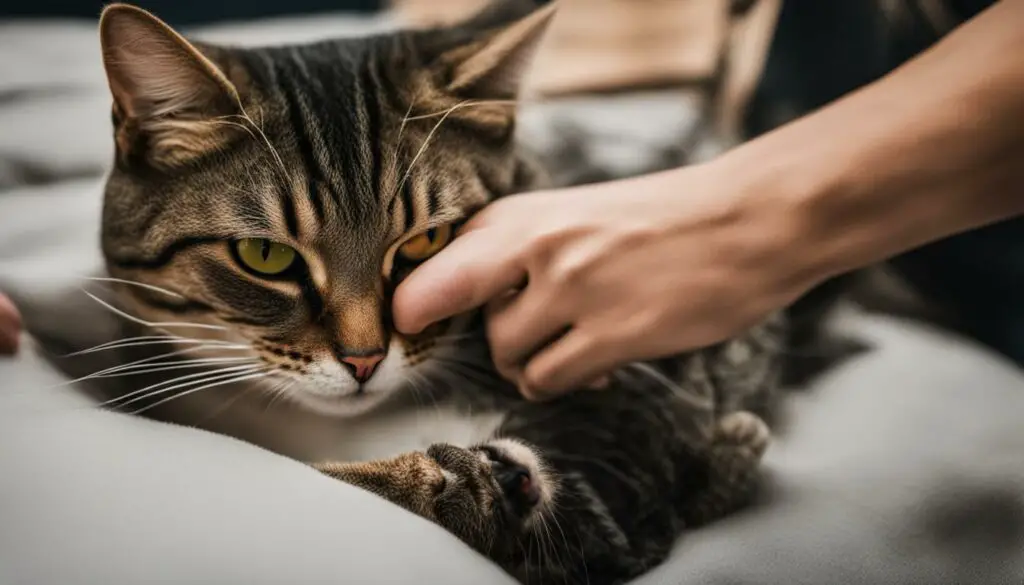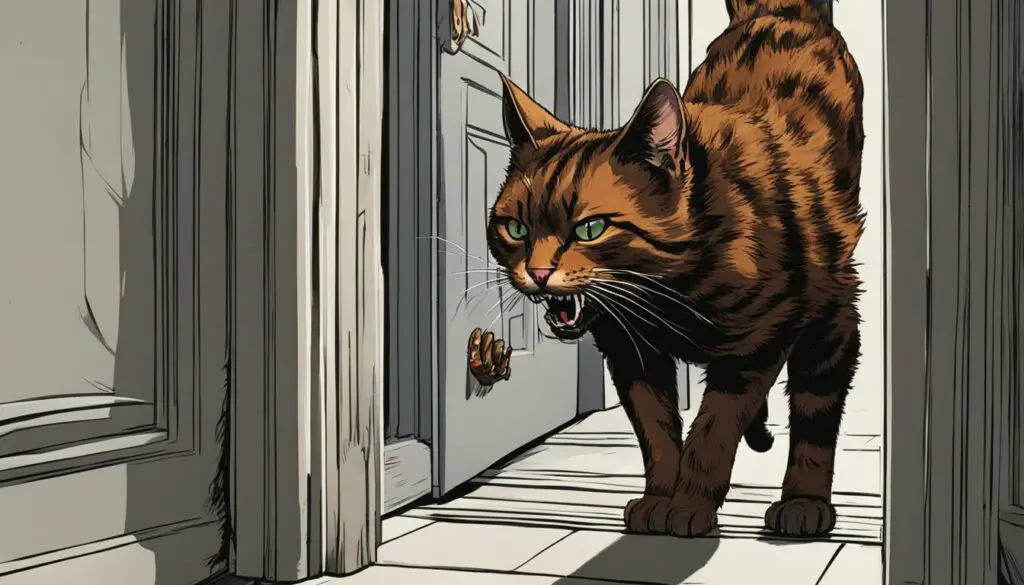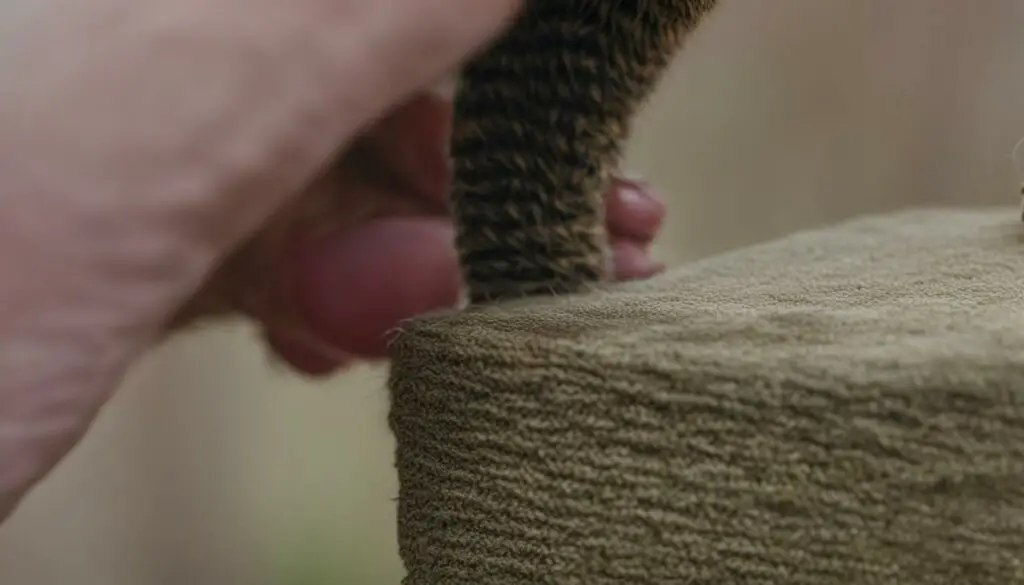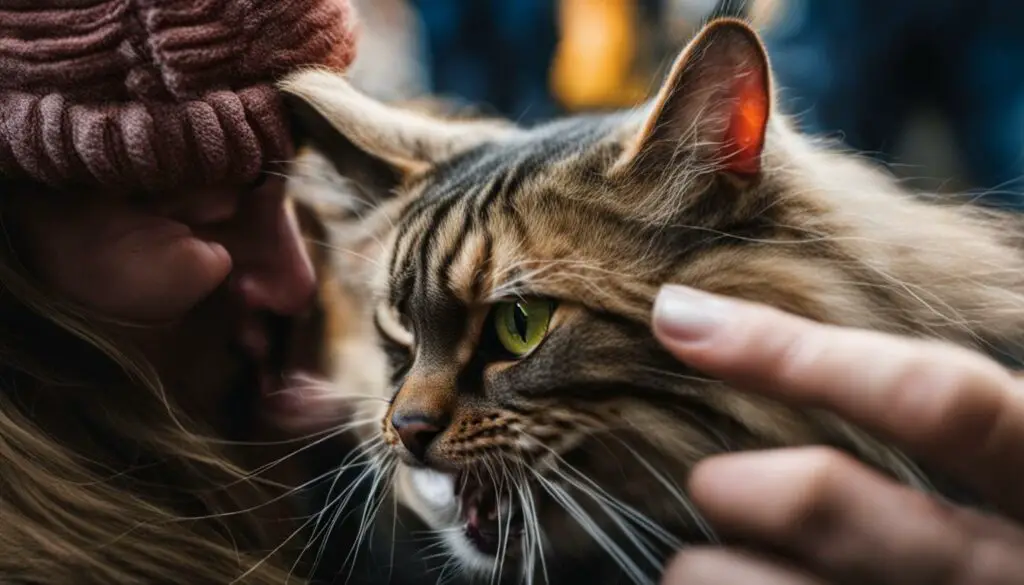Do you find yourself constantly on guard, wary of your cat’s unpredictable and aggressive behavior towards you? Don’t worry, you’re not alone. Many cat owners face the challenge of dealing with cat aggression, but there are solutions to help address and prevent this issue.
Cat aggression can stem from various factors, including underlying behavioral issues, fear, stress, or territorial instincts. By understanding your cat’s behavior and implementing proper training techniques, you can create a harmonious relationship with your feline companion.
In this comprehensive exploration, I will guide you through the various aspects of cat aggression, from identifying the triggers to implementing effective training methods. Together, we’ll unravel the mysteries behind your cat’s behavior and discover strategies to stop cat aggression towards you.
Key Takeaways:
- Understanding your cat’s behavior is crucial in addressing and preventing cat aggression.
- Identifying the triggers for cat aggression, such as anxiety or stress, can help in managing their aggressive tendencies.
- Proper socialization during the kitten stage is essential for preventing cat aggression towards owners.
- Positive reinforcement training techniques, consistency, and patience are key in stopping cat aggression.
- Creating a safe and enriched environment for your cat can help prevent aggression towards both owners and other pets.
Why Do Cats Attack Their Owners?
Cat aggression towards their owners can be a distressing issue for many cat owners. Understanding the reasons behind this behavior is crucial in addressing and preventing it. Cats may attack their owners due to various factors, including play aggression, redirected aggression, fear aggression, territorial aggression, defensive aggression, predatory aggression, or dominance aggression.
Play aggression is common in kittens and younger cats, where they engage in hunting-like behavior with their owners. This behavior involves biting, scratching, and pouncing, but it is not intended to cause harm. Redirected aggression occurs when a cat is aroused or agitated by a stimulus, such as another animal or a loud noise, and redirects their aggression towards their owner.
Fear aggression can occur when a cat feels threatened or scared. This can happen in situations where the cat feels cornered or overwhelmed. Territorial aggression is often displayed when a cat feels its territory is being invaded or challenged. Defensive aggression is a response to a perceived threat or danger.
Predatory aggression is instinctual in cats and is often triggered by movement. This behavior includes stalking, chasing, and pouncing. Dominance aggression can occur when a cat tries to establish dominance over their owner or other pets in the household.
Understanding a cat’s body language and socializing them properly from a young age can help prevent these aggressive behaviors. By recognizing the warning signs and providing appropriate outlets for their natural instincts, such as interactive toys and scratching posts, owners can foster a harmonious relationship with their feline companions.
Table: Types of Cat Aggression Towards Owners
| Aggression Type | Description |
|---|---|
| Play Aggression | Engaging in hunting-like behavior with owners |
| Redirected Aggression | Aggression directed towards owners after being aroused or agitated by external stimuli |
| Fear Aggression | Aggression caused by fear or feeling threatened |
| Territorial Aggression | Aggression triggered by perceived invasion or challenge to the cat’s territory |
| Defensive Aggression | Aggression as a response to a perceived threat or danger |
| Predatory Aggression | Instinctual hunting behavior triggered by movement |
| Dominance Aggression | Aggression aimed at establishing dominance over owners or other pets |
Identifying the Triggers for Cat Aggression Towards Owners
Cat aggression towards owners can be attributed to various triggers, and it is crucial to identify these triggers in order to prevent and address this behavior. Understanding the underlying causes of cat aggression, such as anxiety, stress, fear, or discomfort, can help owners take the necessary steps to create a safe and harmonious environment for their feline companions.
Anxiety and stress are common triggers for cat aggression. Cats are sensitive animals and can easily become anxious or stressed in certain situations. Changes in the environment, such as moving to a new home or the presence of unfamiliar people or animals, can cause them to feel threatened and respond with aggression. It is important to provide cats with a secure and predictable environment to help alleviate their anxiety.
Fear is another significant trigger for cat aggression towards owners. Cats may become fearful if they perceive a threat or feel cornered. This fear can manifest as aggression as a way to protect themselves. Understanding a cat’s body language and recognizing signs of fear, such as flattened ears or dilated pupils, can help owners intervene and manage the situation before it escalates into aggression.
“Cats are highly sensitive creatures and can easily pick up on their owner’s stress or tension. It is important for owners to create a calm and relaxed atmosphere to help reduce their cat’s anxiety and prevent aggression.”
Discomfort or pain can also be triggers for cat aggression. Cats may exhibit aggression towards their owners if they are experiencing physical discomfort or are in pain. It is essential to regularly monitor a cat’s health and seek medical attention if any signs of discomfort or pain are observed. Treating any underlying medical issues can help alleviate their aggression.
By identifying and addressing the triggers for cat aggression towards owners, it is possible to create a safe and peaceful environment for both the cat and its owner. Implementing techniques to reduce anxiety and stress, recognizing and managing fear-based aggression, and ensuring the cat’s physical well-being can all contribute to preventing and managing cat aggression.
| Triggers for Cat Aggression Towards Owners | Prevention and Management |
|---|---|
| Anxiety and stress | Provide a secure and predictable environment, establish routines, and offer hiding places or safe spaces for the cat to retreat to. |
| Fear | Recognize signs of fear in a cat’s body language, create a calm and non-threatening environment, and avoid forcing interactions. |
| Discomfort or pain | Regularly monitor the cat’s health, seek veterinary attention if any signs of discomfort or pain are observed, and provide appropriate medical treatment. |
The Importance of Proper Cat Socialization
Proper socialization during the kitten stage is crucial in preventing cat aggression towards owners. By exposing kittens to different people, animals, and environments, we can help them develop positive associations and reduce the likelihood of aggressive behavior.
During the socialization process, it is important to introduce kittens to various stimuli in a controlled and positive manner. This includes gently handling them, exposing them to different sounds and smells, and gradually introducing them to other cats, dogs, and people.
Creating a safe and enriching environment for kittens is also essential for their development. Providing interactive toys, scratching posts, and vertical spaces can help keep them mentally and physically stimulated, reducing the likelihood of aggressive behavior.
In addition to socialization, consistent positive reinforcement training is key in teaching kittens appropriate behavior. Rewarding good behavior and redirecting any aggressive tendencies can help shape their behavior in a positive way.
By investing time and effort in proper socialization and training, we can help ensure that our cats grow up to be well-adjusted and non-aggressive companions.

The Importance of Early Socialization
Early socialization plays a crucial role in shaping a cat’s behavior and temperament. Kittens that are exposed to positive experiences during their formative weeks are more likely to grow up to be friendly, confident, and well-adjusted cats.
By allowing kittens to interact with different people, animals, and environments, we help them develop positive associations and reduce the risk of fear-based or defensive aggression later in life.
It is important to note that socialization is an ongoing process that should continue beyond the kitten stage. Continuously exposing cats to new experiences and providing positive reinforcement can help prevent aggression towards owners and strangers.
Training Techniques to Stop Cat Aggression Towards Owners
When it comes to addressing cat aggression towards owners, training techniques play a crucial role in modifying behavior and promoting a harmonious relationship. By utilizing positive reinforcement and consistent training methods, owners can effectively manage and prevent aggressive behaviors in their cats.
Redirecting Aggression
One effective technique is redirecting the cat’s aggression towards appropriate outlets. This involves providing interactive toys and engaging in play sessions that encourage the cat to release their energy and predatory instincts in a non-threatening manner. By redirecting their focus onto toys, they learn that play aggression towards their owners is not acceptable.
Rewarding Good Behavior
Positive reinforcement is another valuable training technique. By rewarding desirable behavior, such as being calm or engaging in gentle play, owners can reinforce these actions and encourage their cats to continue displaying them. Rewards can include treats, praise, or even playtime with their favorite toys.
Consistency and Patience
Consistency is key when training cats to stop aggression towards owners. Establishing clear boundaries and consistently enforcing them helps cats understand what is acceptable behavior. Additionally, patience is vital as it may take time for cats to change their behavior. By providing consistent training and allowing for gradual progress, owners can effectively manage and reduce aggression.

Implementing these training techniques can be a valuable tool in preventing and addressing cat aggression towards owners. However, it is essential to approach training with patience, understanding, and respect for the cat’s individual needs and personality. Consulting with a professional trainer or behaviorist can provide additional guidance and support in managing cat aggression.
Understanding Cat Body Language to Prevent Attacks
When it comes to preventing cat aggression towards owners, understanding and interpreting cat body language is crucial. Cats communicate their feelings and intentions through various physical cues, and being able to recognize these signs can help us identify warning signals that may lead to aggressive behavior. By paying attention to their body language, we can take appropriate actions to prevent attacks and maintain a harmonious relationship with our feline companions.

One key indicator of potential aggression is a cat’s posture. When a cat is becoming aggressive, their body may become tense, and they may arch their back or raise their fur. Dilated pupils, hissing, or a swishing tail are also signs that a cat is feeling threatened or agitated. Ears flattened back against the head can indicate that a cat is becoming defensive or preparing to strike. By recognizing these signals, we can give our cats space and avoid interactions that may trigger an aggressive response.
Understanding Facial Expressions
Cat facial expressions can also provide valuable insight into their emotional state. A relaxed and content cat will have soft, half-closed eyes and a slightly open mouth. On the other hand, wide-open eyes and a tense or wrinkled face might indicate fear or aggression. It’s important to note that every cat is unique, and some may have subtle facial expressions that differ from the typical cues. Taking the time to observe and understand our individual cat’s facial expressions can help us respond appropriately in different situations.
Recognizing Vocalizations and Tail Movements
In addition to body language and facial expressions, cats also communicate through vocalizations and tail movements. Growling, hissing, or yowling are warning signs that a cat is feeling threatened or aggressive. A tail that is lashing back and forth rapidly or held high and straight can indicate heightened arousal or aggression. By paying attention to these vocalizations and tail movements, we can adjust our behavior and create a calmer environment for our cats.
Understanding and interpreting cat body language is an essential skill for cat owners. By recognizing the signs of aggression and responding accordingly, we can help prevent attacks and maintain a peaceful relationship with our feline companions.
Creating a Safe and Enriching Environment for Your Cat
As pet owners, it’s our responsibility to provide a safe and enriching environment for our cats. This not only helps prevent aggression towards owners but also promotes their overall well-being. Here are some key ways to create a cat-friendly environment:
1. Provide Plenty of Toys
Cats have natural instincts to hunt and play, and providing them with a variety of toys can help satisfy these needs. Interactive toys, such as puzzle feeders or toys that mimic prey movements, can keep them mentally stimulated and prevent boredom. This can help reduce the likelihood of them redirecting their energy towards aggressive behaviors.
2. Offer Scratching Posts and Vertical Spaces
Scratching is a natural behavior for cats, and having appropriate scratching posts or boards available can help prevent them from scratching furniture or other belongings. Vertical spaces, such as cat trees or shelves, also give cats a sense of security and allow them to observe their surroundings from a higher vantage point.
3. Ensure Access to Essential Resources
Make sure your cat has easy access to essentials such as food, water, and litter boxes. Providing multiple litter boxes in different areas of the house can help prevent territorial disputes. Additionally, placing food and water in separate locations can minimize the chance of resource guarding or aggression towards other pets.

4. Create Safe Zones
It’s important to give your cat a space of their own where they can retreat and feel safe. This can be a cozy bed, a designated room, or even a cat condo. Having a safe zone allows cats to escape from any potential stressors in the environment and reduces the likelihood of them becoming defensive or aggressive.
By following these tips and providing a safe and enriched environment, you can help prevent cat aggression towards owners and create a harmonious living space for both you and your feline companion.
Seeking Veterinary Advice for Cat Aggression Issues
If your cat’s aggression issues persist despite your training efforts, it may be time to seek professional advice from a veterinarian. A veterinarian can assess the underlying causes of your cat’s aggression and recommend appropriate interventions or therapies. It is important to address these issues promptly to ensure the safety and well-being of both you and your cat.
When you visit the veterinarian, be prepared to provide a detailed history of your cat’s aggression, including any triggering events or situations. This information will help the veterinarian better understand your cat’s behavior and tailor their recommendations accordingly. Additionally, the veterinarian may perform a thorough physical examination and possibly run diagnostic tests to rule out any underlying medical conditions that could be contributing to the aggression.
Based on their evaluation, the veterinarian may recommend various treatment approaches. These may include behavior modification techniques, medication, or a combination of both. Behavior modification techniques may involve desensitization and counter-conditioning, where your cat is gradually exposed to the triggers in a controlled manner and taught alternative behaviors. Medications may be prescribed to help manage any underlying anxiety or aggression-related issues.

When to Seek Veterinary Advice:
- If your cat’s aggression is frequent, intense, or escalating in severity.
- If your cat’s aggression is causing injury to you, other pets, or visitors.
- If your cat displays signs of unpredictable or unprovoked aggression.
- If your cat’s aggression is accompanied by other concerning behaviors or changes in appetite, litter box habits, or overall demeanor.
Remember, your veterinarian is your best resource when it comes to addressing cat aggression issues. They have the knowledge and experience to guide you through the process and help you create a harmonious relationship with your feline companion.
Dealing with Cat Aggression Towards Other Pets
Introducing cats to other pets can sometimes be a challenging process, but with the right approach, it is possible to help them coexist peacefully. Here are some techniques that can be effective in dealing with cat aggression towards other pets:
- Gradual Introductions: Introduce the cat and other pet slowly and gradually. Start by allowing them to sniff each other’s scents through a closed door before progressing to visual introductions with a barrier, such as a baby gate.
- Scent Swapping: Swap bedding or toys between the pets to help them become familiar with each other’s scent. This can create a sense of familiarity and reduce territorial aggression.
- Positive Reinforcement: Reward both pets with treats and praise when they display calm and non-aggressive behavior towards each other. This positive association can help them form a bond and reduce aggression.
- Supervised Interactions: Monitor the interactions between the pets closely, especially during the initial stages. Redirect any signs of aggression and separate them if necessary. Gradually increase the duration of their interactions as they become more comfortable with each other.
It’s important to note that each cat is unique, and the process of introducing them to other pets may vary. Patience and consistency are key in helping them adjust to their new companions. If the aggression persists or escalates, it is recommended to seek advice from a veterinarian or a professional animal behaviorist.
| Signs of Cat Aggression Towards Other Pets | Types of Aggression |
|---|---|
| Hissing | Territorial Aggression |
| Growling | Predatory Aggression |
| Swatting or Scratching | Fear Aggression |
| Puffed-up Fur | Defensive Aggression |
| Chasing or Ambushing | Play Aggression |
By implementing these techniques and keeping a close eye on the cats’ interactions, you can help promote a peaceful coexistence between your pets and reduce aggression. Remember to always prioritize the safety and well-being of all pets involved.
Testimonials from Cat Owners:
I followed the gradual introduction technique when introducing my new cat to my resident dog, and it worked wonders! They started off with short, supervised interactions and gradually built a bond. Now they’re best friends and play together every day. Patience and positive reinforcement were key in their successful integration. – Emily, Cat Owner
Scent swapping was a game-changer for my cats. By exchanging their bedding, they became familiar with each other’s scent and became more accepting of each other. It helped to ease their territorial aggression and created a calmer environment. – Tom, Cat Owner

Keeping Children Safe from Cat Aggression
Cats can display aggression towards children for various reasons, including fear, territoriality, or feeling provoked. It is crucial to educate children on how to interact with cats and set boundaries to prevent cat aggression towards them. By following some guidelines, we can ensure a safe and harmonious environment for both cats and children.
Firstly, supervision is key when children and cats interact. Young children should always be supervised while playing with cats to prevent any aggressive behavior. It is important to teach children not to pull tails, grab, or provoke cats, as this can lead to defensive aggression.
Additionally, providing a designated safe space for the cat can help prevent aggression towards children. Cats should have areas where they can retreat and feel secure. This can be a separate room or a high perch where children cannot reach. By giving cats their own space, we can reduce the likelihood of defensive aggression.
Finally, educating children about cat body language can help them understand when a cat wants to be left alone. Teach children to recognize signs such as hissing, flattened ears, or a swishing tail, which indicate that the cat may be feeling stressed or agitated. By respecting a cat’s boundaries and understanding their signals, children can play safely and decrease the risk of aggression.

| Guidelines for Keeping Children Safe from Cat Aggression |
|---|
| Always supervise interactions between children and cats |
| Teach children not to pull tails or provoke cats |
| Provide a designated safe space for the cat |
| Educate children about cat body language and signs of stress |
Addressing Cat Aggression Towards Strangers and Visitors
When it comes to cat aggression towards strangers and visitors, understanding their behavior and providing the right environment is key. Cats are territorial animals, and they may feel threatened or anxious when unfamiliar people enter their space. To address this issue, it is important to implement proper socialization techniques, gradual introductions, and create safe spaces for your cat.

Understanding Cat Behavior
Cats have a natural instinct to be cautious around strangers. They rely on their keen senses and body language to assess potential threats. Signs of aggression towards strangers may include hissing, growling, or their fur standing on end. To reduce aggression, it is important to help your cat feel safe and secure when unfamiliar people are around.
Gradual Introductions
When introducing a new person to your cat, it is important to go slowly and allow your cat to approach at their own pace. Provide a safe and quiet space where your cat can observe the visitor from a distance. Offer treats and positive reinforcement when your cat shows calm behavior. Over time, gradually decrease the distance between your cat and the visitor, always monitoring their reactions and providing additional positive associations.
Creating Safe Spaces
Creating safe spaces for your cat can help alleviate their anxiety when visitors are present. Provide hiding spots like cat trees, shelves, or designated rooms where your cat can retreat to when they feel overwhelmed. Place comfort items like blankets, toys, and scratching posts in these areas to help your cat feel secure. Additionally, it is important to educate visitors on how to interact with your cat, ensuring they understand to approach gently and respect your cat’s boundaries.
By understanding cat behavior, implementing gradual introductions, and creating safe spaces, you can help reduce cat aggression towards strangers and visitors. Patience and consistency are key in managing this behavior, and with time, your cat will feel more comfortable and less likely to display aggression.
Preventing Cat Aggression Towards Hands and Feet
As cat owners, we want to enjoy affectionate interactions with our feline companions without the risk of aggressive behaviors. Preventing cat aggression towards hands and feet is essential for maintaining a harmonious relationship. By understanding their natural behaviors and implementing effective strategies, we can create a safe and enjoyable environment for both cats and humans.
Training and redirection: Teaching cats appropriate play behavior is crucial in preventing aggressive biting or scratching. Avoid using your hands or feet as toys and instead provide interactive toys that allow them to engage in hunting and pouncing activities. Redirect their attention towards these toys whenever they display signs of aggression towards hands or feet. With consistency and patience, cats can learn to associate hands and feet with positive play experiences.
“The key to preventing cat aggression towards hands and feet is to provide appropriate outlets for their natural hunting instincts,” says Dr. Jane Wilson, a renowned feline behaviorist. “By redirecting their focus onto toys and engaging them in interactive play, we can help satisfy their predatory needs and minimize the chances of aggressive behavior.”
Creating a cat-friendly environment: Cats need mental and physical stimulation to prevent boredom and frustration, which can lead to aggression. Ensure your cat has access to scratching posts, climbing structures, and interactive toys that simulate hunting. Providing these outlets for energy and territorial marking can reduce the likelihood of aggressive behaviors towards hands and feet.
Seeking professional guidance: If your cat’s aggression towards hands and feet persists despite your best efforts, it is recommended to consult a veterinarian or a certified animal behaviorist. They can assess your cat’s behavior, identify any underlying health issues or emotional triggers, and provide tailored advice on how to manage and prevent aggression.
By implementing these strategies and understanding your cat’s needs, you can create a safe and enjoyable environment for both you and your feline companion. Remember, patience and consistency are key in preventing cat aggression towards hands and feet.
| Strategies to Prevent Cat Aggression Towards Hands and Feet | Benefits |
|---|---|
| Training and redirection | – Helps cats associate hands and feet with positive play experiences – Reduces the risk of aggressive biting or scratching |
| Creating a cat-friendly environment | – Provides mental and physical stimulation – Reduces boredom and frustration that can lead to aggression |
| Seeking professional guidance | – Veterinary or behavioral expertise can identify underlying health or emotional issues – Tailored advice for managing and preventing aggression |
Managing Cat Aggression Towards Furniture and Possessions
When it comes to cat aggression, one common issue that cat owners face is their furry friends directing their aggression towards furniture and possessions. Not only can this behavior cause damage to our belongings, but it can also be frustrating and challenging to deal with. However, by implementing some effective strategies, we can redirect our cats’ aggression away from our furniture and possessions.
A great way to prevent cat aggression towards furniture is by providing appropriate scratching posts. Cats naturally have the instinct to scratch, and having designated scratching areas can help satisfy this need and discourage them from damaging your furniture. Make sure to choose sturdy scratching posts covered in materials that your cat enjoys, such as sisal or cardboard.
Another effective technique is to offer alternative toys to redirect your cat’s aggression. Interactive toys, such as puzzle toys or treat-dispensing toys, can engage your cat’s mind and provide a healthy outlet for their energy. By keeping them mentally and physically stimulated, they are less likely to resort to aggressive behavior towards your furniture or possessions.
In addition, using deterrents can help discourage your cat from targeting specific areas or objects. Applying double-sided tape or using citrus sprays on furniture surfaces can make them less appealing to your cat. Cats are generally sensitive to textures and scents, and the unpleasant experience can discourage them from engaging in aggressive behavior towards your furniture.

Table: Cat Aggression Towards Furniture and Possessions Prevention Techniques
| Techniques | Description |
|---|---|
| Provide appropriate scratching posts | Offer sturdy scratching posts covered in materials like sisal or cardboard to satisfy your cat’s natural scratching instinct and prevent them from damaging furniture. |
| Offer alternative toys | Engage your cat’s mind and energy by providing interactive toys such as puzzle toys or treat-dispensing toys. |
| Use deterrents | Apply double-sided tape or use citrus sprays on furniture surfaces to make them less appealing to your cat and discourage aggressive behavior. |
By following these strategies, you can help redirect your cat’s aggression away from furniture and possessions. It’s important to note that consistency and patience are key when implementing these techniques. Additionally, providing your cat with plenty of mental and physical stimulation through playtime and enriching activities can decrease their overall aggression levels. Remember, creating a safe and stimulating environment for your cat is essential for their well-being and a harmonious living space for both of you.
Preventing Food-Related Aggression in Cats
Cat aggression towards food and hands can be a common problem for many cat owners. Understanding the underlying causes and implementing appropriate strategies can help prevent and manage this behavior. Here are some tips to address food-related aggression in cats:
1. Consistent Feeding Routines: Establishing regular feeding times can help reduce food-related aggression. Cats thrive on routine, and knowing when to expect their meals can decrease anxiety and prevent aggressive behaviors.
2. Separate Feeding Areas: If you have multiple cats, providing separate feeding areas can minimize competition and reduce the likelihood of aggression. Each cat should have their own bowl and feeding space to avoid food guarding or territorial disputes.
3. Slow-Feeders and Puzzles: Using slow-feeders or puzzle toys can encourage slower eating and mental stimulation. These provide a fun challenge for cats to work for their food, decreasing the likelihood of aggressive behavior during feeding times.
4. Avoid Hand-Feeding: Hand-feeding cats can inadvertently reinforce food aggression. It’s best to use a bowl or dish to offer their meals, avoiding direct contact between your hands and their food. This helps create a clear boundary and avoids triggering any aggressive responses towards hands.
| Table: Common Techniques to Prevent Food-Related Aggression in Cats | |
|---|---|
| Technique | Description |
| Consistent Feeding Routines | Establish regular feeding times to reduce anxiety and prevent aggressive behaviors. |
| Separate Feeding Areas | Provide individual feeding spaces for cats to minimize competition and territorial disputes. |
| Slow-Feeders and Puzzles | Use interactive feeders and puzzles to slow down eating and provide mental stimulation. |
| Avoid Hand-Feeding | Use bowls or dishes to offer meals to avoid reinforcing food aggression towards hands. |
By implementing these strategies, cat owners can create a positive feeding environment and reduce food-related aggression in their feline companions. It’s important to remember that each cat is unique, and it may take time and patience to address their specific needs and behaviors. Seeking guidance from a veterinarian or animal behaviorist can provide additional support and expertise in managing food-related aggression.
Handling Cat Aggression Towards Grooming and Vet Visits
Grooming and veterinary visits can be challenging for cats, leading to aggression and stress. However, with the right approach and techniques, we can help our feline companions become more comfortable and cooperative during these necessary procedures.
Understanding the Causes of Aggression
Cat aggression towards grooming and vet visits often stems from fear and discomfort. Cats may feel threatened by unfamiliar environments, handling, or specific grooming procedures. It is crucial to identify the specific triggers that provoke aggression in your cat to address the issue effectively.
For grooming, some common triggers include sensitive areas like paws or tail, loud noises from grooming equipment, or previous negative experiences. During vet visits, cats may experience anxiety due to the unfamiliar smells, sounds, and interactions with strangers.
Gradual Desensitization and Positive Reinforcement
One effective technique for managing cat aggression towards grooming and vet visits is gradual desensitization. This involves introducing the cat to the triggers in a controlled and gradual manner, allowing them to become accustomed to each step without feeling overwhelmed.
For grooming, start by simply touching and handling the areas that typically trigger aggression, rewarding your cat with praise or treats for calm behavior. Gradually increase the intensity and duration of each grooming session as your cat becomes more comfortable.
Similarly, for vet visits, you can acclimate your cat by bringing them to the clinic for short, positive experiences. Allow them to explore the waiting area, receive treats from the staff, and gradually introduce them to the examination room. This way, they can associate the vet clinic with positive experiences and minimize anxiety.
Consulting a Professional
If your cat’s aggression persists or worsens despite your efforts, it is important to seek professional advice from a veterinarian or a certified animal behaviorist. They can provide tailored guidance and recommend additional strategies to manage the aggression effectively.
| Grooming Tips | Veterinary Visit Tips |
|---|---|
| Handle sensitive areas with care and gentleness. | Bring familiar items, like a blanket or toy, to provide comfort. |
| Use high-value treats or toys to distract and reward your cat during grooming. | Ensure a calm and quiet environment during the examination. |
| Consider using calming products, such as pheromone sprays or calming collars. | Ask the veterinarian to handle your cat gently and minimize restraint. |
| Use positive reinforcement techniques to create positive associations with grooming. | Discuss the possibility of sedation or anti-anxiety medication with your veterinarian if necessary. |
Remember, patience and understanding are key when dealing with cat aggression towards grooming and vet visits. By gradually introducing positive experiences and utilizing appropriate techniques, we can help our cats feel more comfortable and reduce their stress during these important procedures.

Conclusion
As a cat owner, understanding and addressing cat aggression towards owners is crucial for a harmonious relationship with your feline companion. By delving into cat behavior and implementing proper training techniques, you can prevent and manage aggression effectively.
Proper cat socialization during the kitten stage plays a vital role in reducing aggression towards owners. By exposing them to various people, animals, and environments, you help them develop positive associations and minimize the likelihood of aggressive behavior.
Positive reinforcement training techniques, such as rewarding good behavior and redirecting aggression, are key in stopping cat aggression towards owners. Consistency and patience are essential when implementing these methods to ensure long-term success.
Creating a safe and enriched environment for your cat is equally important. Providing plenty of toys, scratching posts, and vertical spaces, along with access to food, water, and litter boxes, helps prevent aggression towards owners and other pets.
Remember, if your efforts to address cat aggression persist without improvement, seeking professional advice from a veterinarian is crucial. They can assess the underlying causes and recommend appropriate interventions or therapies.
FAQ
Why do cats attack their owners?
Cats may attack their owners due to play aggression, redirected aggression, fear aggression, territorial aggression, defensive aggression, predatory aggression, or dominance aggression.
How can I prevent cat aggression towards me?
Understanding cat behavior, implementing proper training techniques, and providing a safe and enriched environment can help prevent cat aggression towards owners.
What are the triggers for cat aggression towards owners?
Triggers can include anxiety, stress, fear, or discomfort. Identifying and addressing these triggers is important in preventing cat attacks.
How can I socialize my cat to prevent aggression?
Proper socialization during the kitten stage, exposing them to different people, animals, and environments, can help reduce the likelihood of aggressive behavior.
What training techniques can I use to stop cat aggression towards me?
Positive reinforcement training techniques, such as rewarding good behavior and redirecting aggression, can be effective in stopping cat aggression towards owners.
How can I understand cat body language to prevent attacks?
By understanding and interpreting cat body language, such as hissing, raised fur, dilated pupils, or flattened ears, owners can identify warning signs of aggression and take appropriate actions.
How can I create a safe environment for my cat to prevent aggression?
Providing toys, scratching posts, and vertical spaces, as well as ensuring access to food, water, and litter boxes, can help prevent aggression towards owners and other pets.
What should I do if cat aggression issues persist?
Seek professional advice from a veterinarian who can assess the underlying causes of aggression and recommend appropriate interventions or therapies.
How can I introduce my cat to other pets without aggression?
Introduce cats to other pets gradually and under supervision, using techniques such as scent swapping, gradual introductions, and positive reinforcement to help them adapt and coexist peacefully.
How can I keep my children safe from cat aggression?
Supervise interactions between children and cats, teach children not to pull tails or provoke cats, and set boundaries to prevent cat aggression towards children.
How can I prevent cat aggression towards strangers and visitors?
Proper socialization, creating positive associations through treats and gentle interactions, and providing safe spaces can help reduce aggression towards strangers and visitors.
How can I prevent cat aggression towards hands and feet?
Teach cats appropriate play behavior, discourage rough play with hands and feet, and provide interactive toys to redirect their attention.
How can I prevent cat aggression towards furniture and possessions?
Provide appropriate scratching posts, offer alternative toys, and use deterrents like double-sided tape or citrus sprays to redirect cats’ aggression away from furniture and possessions.
How can I prevent food-related aggression in cats?
Establish consistent feeding routines, provide separate feeding areas for multi-cat households, and use slow-feeders or puzzles to prevent food aggression. Avoid hand-feeding and not taking away food while eating can also help.
How can I handle cat aggression towards grooming and vet visits?
Gradual desensitization and positive reinforcement training can help cats become more tolerant of grooming and vet visits. Techniques such as treats, praise, and gentle handling can build trust and reduce fear-based aggression.
Source Links
- https://vcahospitals.com/know-your-pet/play-and-predatory-aggression-in-cats
- https://www.wikihow.pet/Make-Your-Cat-Stop-Attacking-You
- https://www.purina.co.uk/articles/cats/behaviour/training/how-to-stop-cats-fighting








